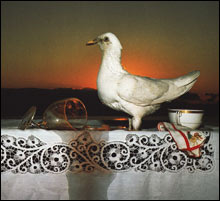
Barbara Norfleet, White Pigeon and Broken Wineglass (1986) |
One hundred corrugated cardboard monkeys hanging from trapezes greet visitors to “GOING APE: CONFRONTING ANIMALS IN CONTEMPORARY ART,” which opens at the DeCordova Museum and Sculpture Park on September 2. The playful primates, with their limber limbs and tails extravagantly intertwined to create curling patterns in space, are the creation of Connecticut-based artist James Grashow, and they serve as a lively introduction to the dense menagerie promised by this show. “Going Ape” includes work by 19 artists and one artist team, Russian duo Vitaly Komar & Alex Melamid, who came to the US from the USSR in the late ’70s as dissident conceptual artists combining Soviet Realism with Pop Art and are now collaborating with elephants in Thailand to produce paintings to raise awareness of the plight of these threatened creatures. The rest of the work is made exclusively by humans, and it explores themes including our personal contact with the nearly wild (a skunk on the picnic table, a bird at the feeder), our representation of the animal world through art history and also through toys, our tendency to anthropomorphize, and our anxieties about bio-engineering.Long before elephants picked up paintbrushes, Brooklyn-born painter George McNeil (1908–1995) was developing his artistic craft in New York. A founding member of the American Abstract Artists group in 1936, McNeil made work that until the late 1950s was all about pictorial structure and color relationships, with dynamic planes of bold color and forms that bounced with energy. Around this time, however, figures began to emerge from his abstract canvases, and over the next decades they became his main subject. In the 1980s, he experienced a resurgence of success when the popularity of Neo-Expressionism formed a receptive context for his work. Like his own teacher, Hans Hofmann, he was an influential educator as well as an inspired artist, as can be seen in “MAKING IT NEW: GEORGE MCNEIL & HIS STUDENTS,” which opens at Montserrat College of Art’s Montserrat Gallery on August 28. The students include Thorpe Feidt, Rose Olson, Adele Travisano, and Maxine Yalovitz-Blankenship.
Images of children and childhood in contemporary art can be pretty weird, but then, childhood can be pretty weird. “OFFSPRING: REPRESENTATION OF CHILDREN IN CONTEMPORARY VISUAL CULTURE,” which opens at the Boston University Art Gallery on September 5, looks to put modern youth into perspective, offering not only compelling work by nine artists (including Christin Couture, Nicky Hoberman, Loretta Lux, and Jane Smaldone) but also images pulled from advertising and popular culture and artwork made by children. The title “offspring” alone seems to signal a quirky and unsentimental take on this topic.
“GOING APE” at DeCordova Museum and Sculpture Park, 51 Sandy Pond Road, Lincoln | September 2–January 7 | 781.259.8355 | “MAKING IT NEW: GEORGE MCNEIL & HIS STUDENTS” at Montserrat Gallery, Montserrat College of Art, 23 Essex St, Beverly | August 28–October 28 | 978.921.4242 x 1319 | “OFFSPRING” at Boston University Art Gallery, 855 Comm Ave, Boston | September 5–October 8 | 617.353.3329
On the Web
Boston University Art Gallery: www.bu.edu/art
Montserrat Gallery: www.montserrat.edu/galleries
DeCordova Museum and Sculpture Park: www.decordova.org